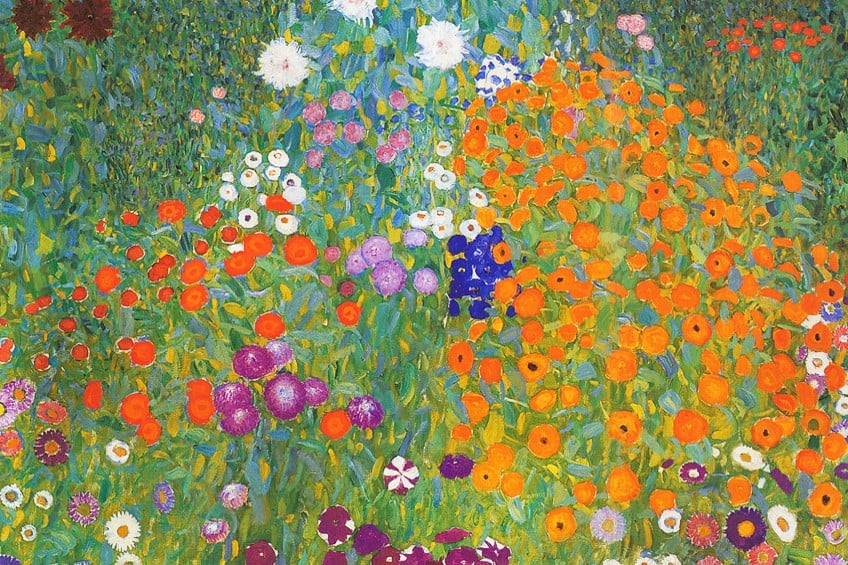Famous Flower Paintings – Exploring the Best Floral Paintings
What makes floral artwork so significant? And do the art styles of the world’s most popular floral paintings have any correlation to their symbolism? Since 2.6 million years ago, humans have been creating floral paintings across Europe, portraying the diverse beauty of the natural environment for different purposes. Over time, and with the development of civilizations across the world, people began attributing symbolic meanings to the flora and fauna around them, such that floral artwork became a medium through which various concepts and messages could be relayed. In this article, we will introduce you to the most famous flower paintings in art history, from Monet’s flowers to Contemporary legends like Yayoi Kusama. Read on for more insight into these timeless and romantic paintings of flowers!
Flower Power: The Significance of Flowers in Art History
The inclusion of flowers in artwork has been traced back to 2.6 million years ago in the prehistoric age of mankind, the Paleolithic era, and first appeared in cave paintings across France and Spain. It was believed that the human fascination with flowers may have temporarily ended around 10,000 BCE, however, from what we know today, flowers are very much still a major part of art history and should not be overlooked.
What then, is the significance of flowers in art history? When examining the early history of flowers and their appearance in prehistoric artwork, our early ancestors chose to recreate the structure of flowers on cave walls for various religious and spiritual practices.
Colorful flowers were also crushed and used to create prehistoric pigments that date back many thousands of years ago. Most of the early flower paintings portray flowers such as lilies, poppies, and irises, all of which were appreciated for different aesthetic reasons. Aside from their artistic function, flowers debuted in art as a method to communicate information about the environment and include information about seasonal changes and the location of food sources.

Regardless of the utilitarian function of flowers, artists operating during the 15th and 16th centuries also felt a sense of connection to the flora and fauna of their environment. The Middle Ages were also a period of heightened interest in floral artwork and decor, with many artists including floral imagery in their manuscripts and calligraphic artworks. The late Renaissance period in Europe was also a major period in the emergence of botanical painting, which was a distinct art form practiced in collaboration with the natural sciences.
The 16th century produced many artists who were intrigued by botanical painting and created many iconic illustrations of plants for scientific texts and botanical studies. These were usually executed in watercolor or ink and were highly detailed.
Among the many notable artists who painted flowers of the late Renaissance was Flemish painter Pierre-Joseph Redouté, who was most famous for his precise watercolor flower illustrations and was considered to be a highly influential figure in the history of botanical art. In addition to flower paintings that were rooted in scientific contribution and botanical painting, floral artworks also helped scientists with conservation efforts and the identification of different species of flowers.
Exploring Popular Symbols in Floral Art
There are many floral artworks executed in a variety of art styles that relay different messages while representing flowers that serve a symbolic purpose. Whether the floral artwork is Romantic, Impressionist, abstract, or bold and colorful, the flower will always carry a level of symbolism. Below, we will look at a few specific and popular flowers in art history that carry deep meaning and symbolism in the artworks to follow.
By diving into the embedded symbolism of specific flowers, you can develop a higher appreciation for these natural beauties!
The Rose
The rose in art history is among the most popular flowers to feature across art periods and cultures in the world. Ancient Greek and Roman artworks adopted the rose as a symbol of love, and beauty, and was affiliated with the Greek Goddesses Aphrodite and Isis. Like the lily, the rose was also used in ceremonial practices and portrayed in paintings of floral garlands.
Christian artwork also used the rose to allude to themes of love, the Virgin Mary, martyrdom, and the blood of Christ.
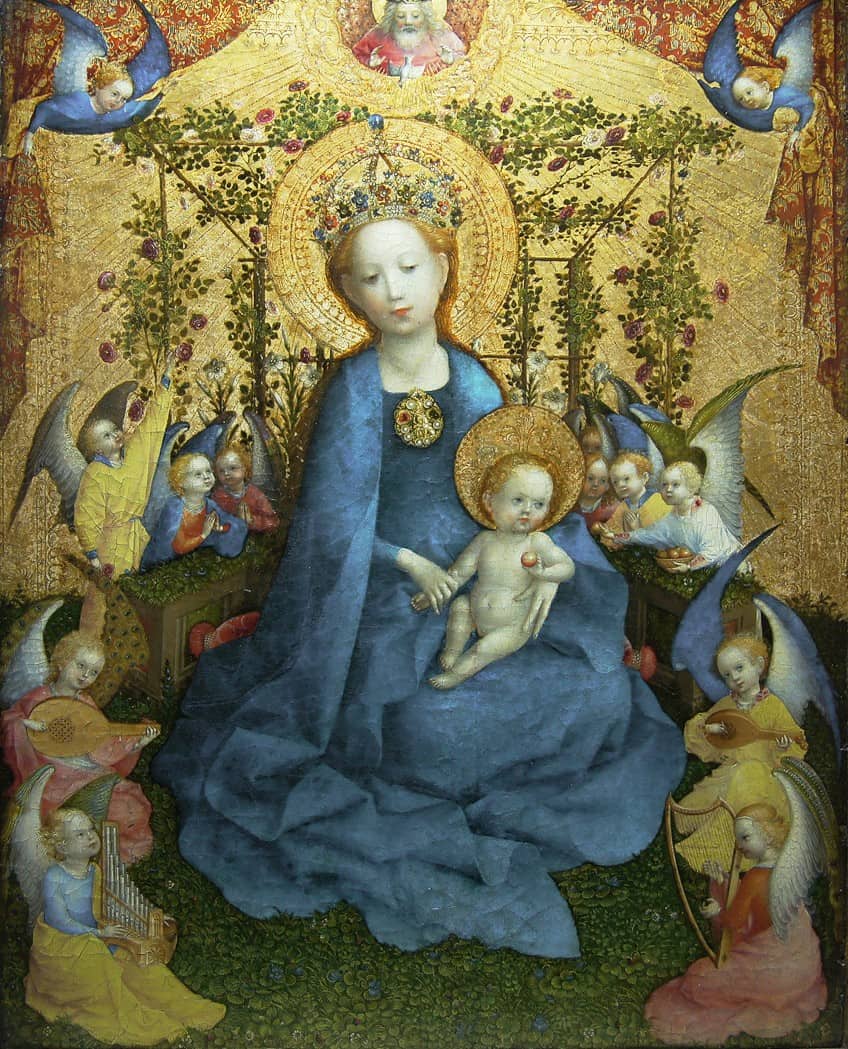
The white rose was traditionally used in cases where innocence and purity were the focus of artists and can be seen in works such as Madonna of the Rose Bower (c. 1440 – 1442) by Stefan Lochner. Roses were also prominent symbols in Islamic art that alluded to paradise, beauty, and the Prophet Muhammad. Many calligraphy artworks also included the rose as decorative motifs. Modern flower paintings use the rose to convey messages of beauty, emotion, passion, sensuality, and intimacy as seen in works by Modern artists such as Georgia O’Keeffe.
The Lotus Flower: Nymphaea and Nelumbo
The lotus flower is one of the most popular flowers used in art history and represents specific themes and religious concepts. The use of the lotus flower in art was most famously employed in ancient Egyptian art as well as by artists in Asia to represent various spiritual belief systems. In ancient Egypt, the Nymphaea lotus was established as a symbol of creation and rebirth and was often portrayed as emerging out of the dark waters of the Nile River to represent the cycle of life and death.
Other Egyptian connotations included the lotus’ association with the Egyptian sun God Ra. The Nymphaea caerulea flower or blue lotus flower was also used in ceremonies and was seen as a medium that carried psychoactive properties.
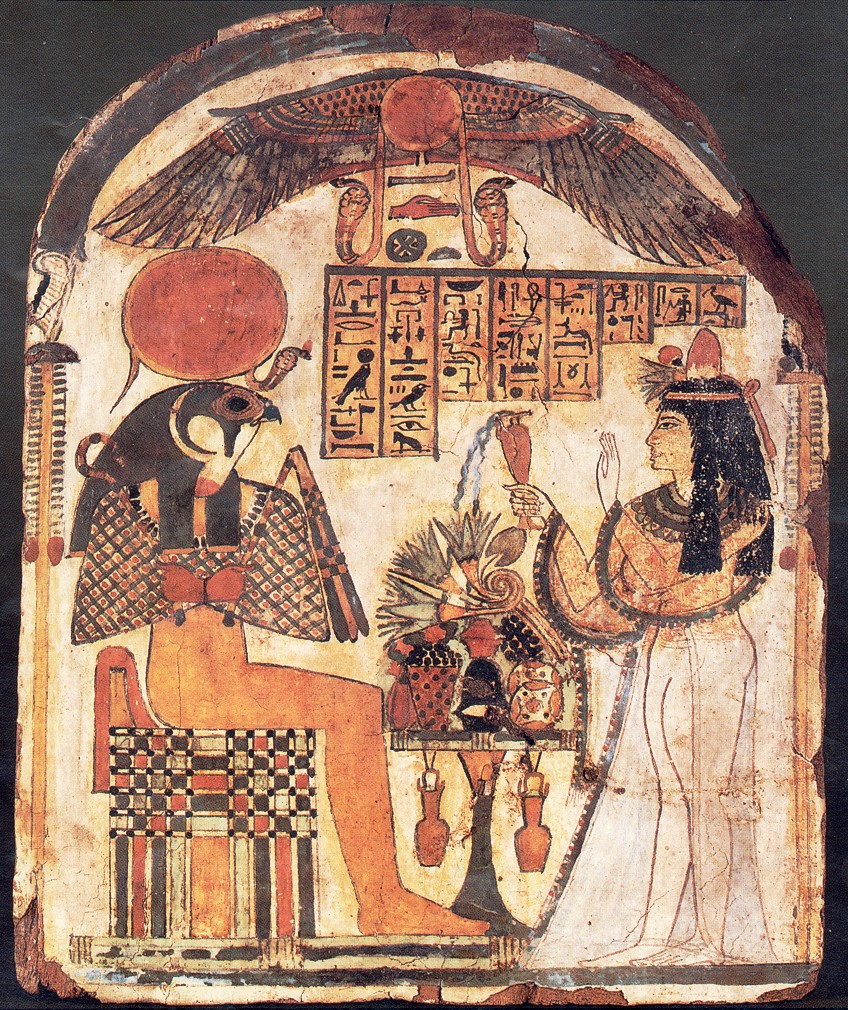
In India, religious factions such as Buddhism and Hinduism saw the lotus flower, Nelumbo nucifera, as a symbol of spiritual growth, enlightenment, and purity. The lotus flower has also been featured numerous times in Indian art as a sacred symbol. It is also associated with the Hindu Gods Lakshmi and Vishnu, as found in religious iconography and temple artworks. In China and Buddhist belief systems, the lotus flower symbolized the path to enlightenment and was a sign of the development of the mental state. Popular representations of the lotus in Chinese art include the lotus as a peaceful flower, best known for its petals painted with graceful and sinuous arcs. The lotus became a symbol of harmony, inner peace, and balance and is most famous for its place in the context of a Buddhist text called the Lotus Sutra, renowned for its teaching of wisdom and compassion.
The Lily
You may instantly be drawn to the “modern” representation of the lily in art as seen in the flower paintings by Claude Monet, however, the lily featured in earlier artworks across Christianity, ancient Greece, and Rome, as well as Asian artworks and then Modern art. Ancient Greek and Roman artists saw the Lilium candidum as a symbol of eroticism and fertility, which was closely connected to the mythological figures Hera (Greek) and Juno (Roman) in art history, who were recognized for their sensuality and beauty.
The lily was often portrayed alongside depictions of garlands, and floral wreaths, and in secular and religious events.
In Christian-themed artwork, the lily symbolizes purity and the innocence of the Virgin Mary. It was a flower made incredibly popular by Christian iconography and was often portrayed in white or golden hues. The lily was also a symbol of the holy trinity and can be seen in famous Christian paintings such as the Annunciation by Sandro Botticelli where Mary is presented with a lily by the archangel Gabriel.

In Asian artwork, the lily employs different meanings and was primarily a symbol of femininity, grace, and purity. The Lilium longiflorum was used in Japanese artwork while the Lilium brownii was used in Chinese lily paintings. Its most admirable quality was its elegance and artists specifically looked up to its symmetrical quality. Chinese lily symbols served to represent good fortune and became known as a symbol of wealth used in feng shui practices to attract financial abundance. Similarly, in Modern flower paintings, the lily was used as a symbol of beauty and elegance as seen in Monet’s flowers and Nymphaeaceae paintings of the late 19th and early 20th centuries.
The Sunflower
The sunflower in art history has remained an iconic flower that was popularized by post-Impressionist Vincent van Gogh. However, the sunflower also carries a deeper meaning for other art styles and cultures, including the Native American culture, which adopted the sunflower as a symbol of humans’ connection to the earth, vitality, and an icon of nourishment. Sunflowers were common crops in pre-colonial and colonial America, which were harvested for their seeds and used as a source of medicine, food, and oil. The sunflower is also featured in spiritual practices and is commonly associated with the sun.
Christian artworks also revered the sunflower as a symbol of faith, spiritual enlightenment, and devotion, which was associated with light and the presence of God.
The petals of the sunflower were also associated with the holy trinity and were best represented by Van Gogh as a symbol of divine beauty. Before Van Gogh, Impressionists such as Pierre-Auguste Renoir and Monet also painted the sunflower to capture its brilliant colors in the light and capture the energy of nature itself. As such, flowers in Impressionist artworks were seen as still-lifes of the beauty of nature and romantically as the passage of time.

In Contemporary and Modern flower paintings, the sunflower evolved as a symbol of resilience, optimism, and hope. The sunflower became more emotive and focused on its use as a metaphor for human resilience and perseverance in the struggles against challenging times. As such, artists tend to adopt the concept of the sunflower’s ability to always face the sun, which was best demonstrated in Contemporary works by artists such as Yayoi Kusama. Other famous artists who paint flowers include David Hockney, Andy Warhol, Frida Kahlo, Joan Mitchell, and Takashi Murakami among many other artists with unique approaches to floral painting.
A Selection of the 15 Most Famous Flower Paintings of All Time
One can go on and on about the countless symbols employed in floral artwork, however, luckily for you, we have narrowed it down to a selection of the top 15 most famous flower paintings of all time! While you are at it, make note of the wonderful ways in which these artists have included their unique views and art styles to represent flowers and create stunning, ethereal, and bold works of art that evoke the beauty of nature.
Flower Still-Life (1614) by Ambrosius Bosschaert
| Artist Name | Ambrosius Bosschaert the Elder (1573 – 1621) |
| Date | 1614 |
| Art Period | Dutch Golden Age |
| Medium | Oil on copper |
| Dimensions (cm) | 30.5 x 38.9 |
| Where It Is Housed | The J. Paul Getty Museum, Los Angeles, United States |
Ambrosius Bosschaert the Elder was among the first famous flower artists of the Dutch Golden Age to create floral paintings featuring highly-detailed compositions and is an excellent example of the heightened interest of 17th-century Baroque painters in botanical art. Ambrosius Bosschaert was already a leader of Baroque flower paintings who went on to influence many Netherlandish artists.
Flower Still-Life is one of the most famous flower paintings executed on copper and rendered in such detail that it can be compared to scientific illustrations.

The composition features a white rose in the foreground as well as a yellow tulip and a pink carnation. The basket of flowers contains flowers from different seasons and is scattered with vivid hues of violet, pink, and yellow, all of which evoke a sense of freshness and youth. Bosschaert used the appeal of detail to visually communicate the beauty, delicacy, and fragility of nature by highlighting elements such as the silky texture of the flower petals and the translucency of the dragonfly’s wings. Through careful observation, Bosschaert exquisitely illustrated the brevity of life, which reminds one of the transience of beauty.
Bullfinch and Weeping Cherry Blossoms (1829 – 1839) by Hokusai Katsushika
| Artist Name | Katsushika Hokusai (1760 – 1849) |
| Date | 1829 – 1839 |
| Art Period | Ukiyo-e |
| Medium | Color woodblock print (known as Chūban) |
| Dimensions (cm) | 25.4 x 19.1 |
| Where It Is Housed | Art Institute of Chicago, Illinois, United States |
Katsushika Hokusai is among one the most celebrated Japanese flower painters of the Edo period. Known professionally as Hokusai, the renowned artist had a significant influence on Western-European art through the adoption of Japanese Ukiyo-e printing and other representations of Japanese cultural motifs during the 19th century. Hokusai was most famous for his art style of woodblock printing, which featured fluid sinuous lines and popular Japanese motifs inspired by nature, including cherry blossoms, which have been illustrated in Bullfinch and Weeping Cherry Blossoms.
The woodblock printing master created Bullfinch and Weeping Cherry Blossoms as part of an untitled series of flowers and birds created between 1829 and 1839.

The artwork is currently housed at the Art Institute of Chicago and portrays a small bullfinch dangling by its feet from the branches of a weeping cherry tree. The tree is portrayed in full bloom and is a nod to the Japanese cultural symbol of the fleeting nature of beauty and life represented by the cherry blossoms. The painting was also inspired by an appreciation of the ephemeral, also known as Mono no aware. The symbolism behind the bullfinch was also significant since it represented good luck and was a messenger for one of Japan’s greatest scholars, Kami Tenjin-Sama.
Lilacs in a Window (1880 – 1883) by Mary Cassatt
| Artist Name | Mary Stevenson Cassatt (1844 – 1926) |
| Date | 1880 – 1883 |
| Art Period | Impressionism |
| Medium | Oil on canvas |
| Dimensions (cm) | 61.5 x 51.1 |
| Where It Is Housed | Metropolitan Museum of Art, New York City, United States |
Mary Cassatt was one of the most famous flower artists and American Impressionist painters of the 19th century who was best known for her contributions to the Impressionist movement spanning Europe and America. Impressionism was perhaps the most popular art movement that birthed the emergence of alternative and unique representations of flowers in art history. This was owed to the fact that many Impressionists focused on demonstrating the effects of light on everyday Contemporary subjects, including still-lifes and flowers.
Lilacs in a Window is considered to be a rare painting in Cassatt’s portfolio, since she spent the majority of her time focusing on human subjects.
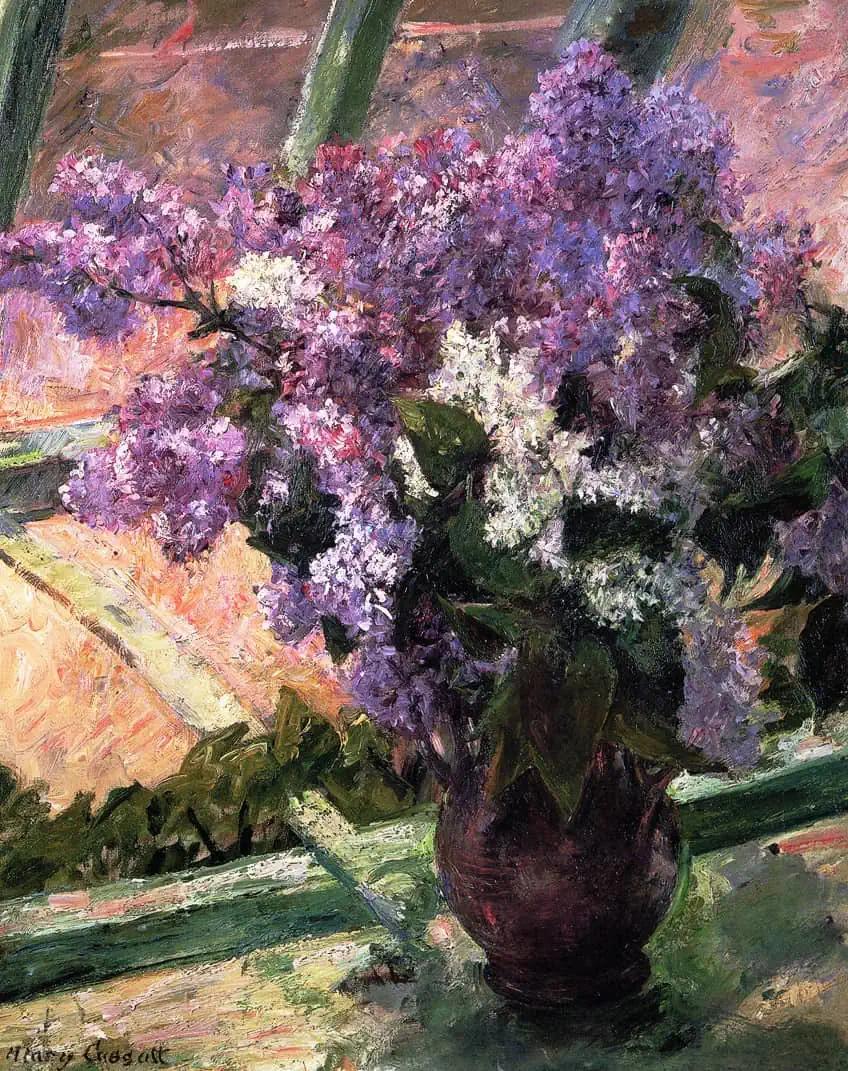
Through a simple pointillist approach to the flower arrangement, Cassatt beautifully rendered the lilacs and highlighted the textural quality of the petals. In the Victorian age, lilacs were often presented as a gift to express one’s affection or love and were featured in art as a motif for romance. They were also frequently used in bridal bouquet arrangements and symbolized the purity and innocence of the bride. Lilacs in a Window was originally owned by one of Cassatt’s early patrons, Moyse Dreyfus, who was a well-known art collector.
Roses and Lilies (1888) by Henri Fantin-Latour
| Artist Name | Henri Fantin-Latour (1836 – 1904) |
| Date | 1888 |
| Art Period | Realism and Symbolism |
| Medium | Oil on canvas |
| Dimensions (cm) | 59.7 x 45.7 |
| Where It Is Housed | Metropolitan Museum of Art, New York City, United States |
French Realist and Symbolist painter Henri Fantin-Latour offers a more traditional approach to representing flowers in paintings. Fantin-Latour was inspired by the golden age of Realism and was best known for his contribution to still-life flower paintings. The French master demonstrated his talents for carefully curated compositions and an expert handling of color by accentuating the surface and textural qualities of the flowers and the vase in Roses and Lilies. Many of his works feature flowers such as peonies, roses, and chrysanthemums, which display his mastery of different floral textures and colors.
Through subtle color variations, Fantin-Latour also brought a dream-like effect to his flower paintings while showing off his in-depth understanding of all the detail that the natural world has to offer.
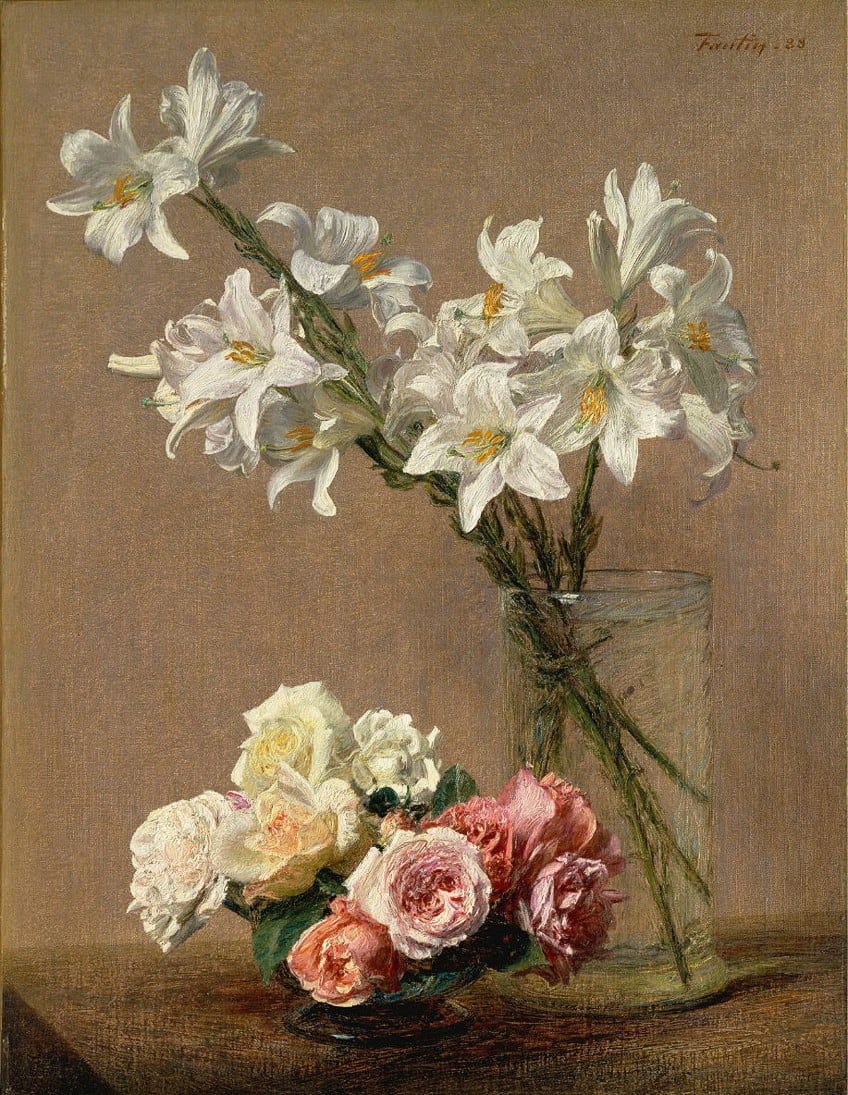
Roses and Lilies is by far the most stunning example of Fantin-Latour’s mastery of flower artwork and portrays an elegant bouquet of roses and lilies depicted with soft and velvety textures, which invites the viewer to experience their beauty. The color of the roses contrasted against the cream-colored lilies is also what makes the flower artwork stand out and propels one into an immersive visual experience where one can appreciate the timeless nature of paintings of flowers.
Still Life Vase with Twelve Sunflowers (c. 1888 – 1889) by Vincent van Gogh
| Artist Name | Vincent Willem van Gogh (1853 – 1890) |
| Date | c. 1888 – 1889 |
| Art Period | Post-Impressionism |
| Medium | Oil on canvas |
| Dimensions (cm) | 91 x 71 |
| Where It Is Housed | The Neue Pinakothek, München, Germany |
“I’m thinking of decorating my studio with half a dozen paintings of sunflowers.” Still Life Vase with Twelve Sunflowers is part of Vincent van Gogh’s popular series of sunflower paintings created in Arles between 1888 and 1889. The painting originally featured 12 sunflowers as stated in the title, however, Van Gogh later decided to add three more sunflowers to the vase and as such, the painting became a still life of 15 sunflowers. Vincent van Gogh was perhaps the most remarkable painter of the Post-Impressionist movement whose signature style has not been successfully replicated.
Van Gogh was deeply moved by the nature of sunflowers and sought to express their symbolic beauty through the passage of time and its effect on the color of sunflowers.

The famed post-Impressionist was inspired by the vitality and energy that sunflowers possessed and wanted to draw attention to the way that they shone through a brilliant array of ochres, yellows, and umber. He first began his sunflower paintings in 1887 while residing with his brother, Theo, in Paris. Van Gogh also experimented with ideas of decay, death, and the sunflower as a source of light and warmth until he died in 1890. At one point, the Dutch master also expressed to Theo that he viewed sunflowers as “a whole future” and sought to capture their beauty through painting, the latter of which you can agree was incredibly successful.
Irises (1890) by Vincent van Gogh
| Artist Name | Vincent Willem van Gogh (1853 – 1890) |
| Date | 1890 |
| Art Period | Post-Impressionism and Modern art |
| Medium | Oil on canvas |
| Dimensions (cm) | 73.7 x 92.1 |
| Where It Is Housed | Metropolitan Museum of Art, New York City, United States |
Created in the same year of his tragic death, Vincent van Gogh provided us with yet another iconic flower painting, Irises, which showcases the artist’s masterful handling of subtle tonal variations in his neutral cool blue-green color palette. Irises were created during Van Gogh’s stay at the Saint-Paul-de-Mausole psychiatric hospital. During this period, Van Gogh experienced numerous mental breakdowns while also creating his most famous painting Starry Night.
Despite his time at the institution being the most challenging and productive, he managed to capture and express his admiration for the finer artworks of nature as seen in Irises.

As his mental state deteriorated, he also saw many vivid hallucinations, which perhaps informed his art style as seen through his bold brush strokes and heightened use of color during this time. He also described his experiences at the institution as “the lightning conductor” for his illness and as such embedded his last moments of sanity by honoring the beauty of the world as he saw it through flowers.
Flower Garden (1905) by Gustav Klimt
| Artist Name | Gustav Klimt (1862 – 1918) |
| Date | 1905 |
| Art Period | Art Nouveau, Vienna Secession, Symbolism, and Modern art |
| Medium | Oil on canvas |
| Dimensions (cm) | Unavailable |
| Where It Is Housed | Unavailable |
Flower Garden was a popular flower painting by Gustav Klimt, which was created in the early 20th century and is currently regarded as a lost painting. This famous flower painting was last exhibited to the public in 1905 at the Viennese Kunstschau exhibition alongside works by other artists of the Vienna Secession movement. Flower Garden represents Klimt’s interest in a field of flowers he encountered while visiting Litzlberg and is dubbed one of his best landscape paintings to date. Klimt was a pioneer of the Vienna Secessionists who also had a talent for composing visually stunning and evocative floral artworks.
Klimt’s painting style for floral artworks showcases his approach to natural subjects through a fusion of ornamental motifs and naturalistic representations, which creates mesmerizing effects.
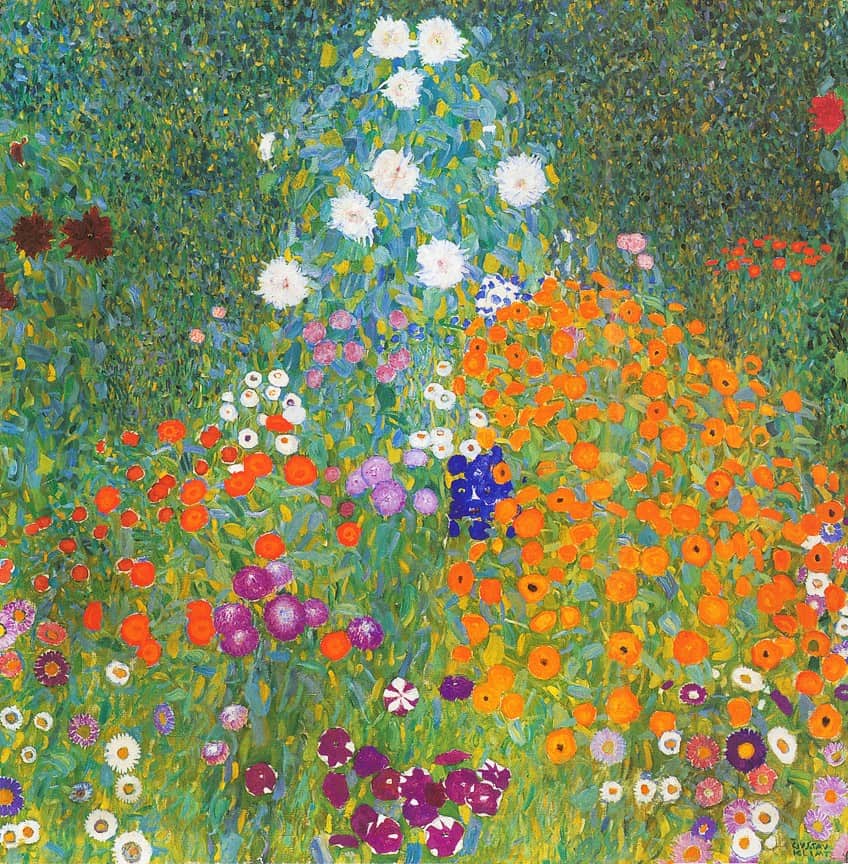
Klimt was also known to paint sunflowers, with his second most famous floral artwork being The Sunflower (1906), which also reflects his eye for creating depth and movement using color and three-dimensional painting techniques. Additionally, Klimt’s use of symbolism and floral patterns also represented his emotions toward natural elements and functioned as a tool for creating harmony and illustrating the connections between living things.
Flowers (1907) by Henri Matisse
| Artist Name | Henri Émile Benoît Matisse (1869 – 1954) |
| Date | 1907 |
| Art Period | Fauvism, Impressionism, Post-Impressionism, Neo-Impressionism, and Modernism |
| Medium | Oil on cardboard |
| Dimensions (cm) | 34 x 26 |
| Where It Is Housed | San Francisco Museum of Modern Art, San Francisco, United States |
Henri Matisse was one of the most influential abstract Impressionist flower artists of the early 20th century whose unique approach to abstraction as a tool for abstraction and symbolism was lauded by many. Matisse was also a leading Fauvist artist who experimented with many Modern art styles of the 20th century and was best known for his bold use of color throughout his flower paintings.
Flowers by Matisse is a 1907 oil painting that illustrates the abstract impasto and gestural quality of the artist’s style while presenting a small bouquet of vibrant flowers, identified by their splotches of solid color arranged in contrast to the white vase.
Matisse was famous for his flat two-dimensional style of painting, which was a typical painting approach used by many Fauvist painters. Flowers is also viewed as an exceptional floral artwork from the artist’s early career that distinguished him from other abstract artists of the time. His style celebrated new ways of viewing and appreciating the natural world through simplified forms, bold colors, and dynamic compositions. Each color was carefully selected to create a sense of modernity and vitality as illustrated by his brushwork and choice of color. Compared to the detailed depictions of flowers and still-lifes in the history of art, Matisse’s Flowers can be considered a masterpiece in floral painting.
Water Lilies (1908) by Claude Monet
| Artist Name | Oscar-Claude Monet (1840 – 1926) |
| Date | 1908 |
| Art Period | Impressionism and Modern Art |
| Medium | Oil on canvas |
| Dimensions (cm) | 81 (d) |
| Where It Is Housed | ARoS Aarhus Art Museum, Aarhus, Denmark |
One cannot discuss the world’s most famous flower paintings without mentioning the Water Lilies series by Claude Monet. Monet was perhaps the greatest flower painter of the 20th century who was not only a leader in French Impressionism, but also one of the most iconic figures of Modern art. His approach to flower painting was inspired by his loose brushwork and his admiration of the world around him.
In keeping with the themes of harmony and peaceful landscapes, Monet created the series Water Lilies between the 1890s and the 1920s, up until his death, and created around 250 paintings of scenes from his water garden in Normandy.
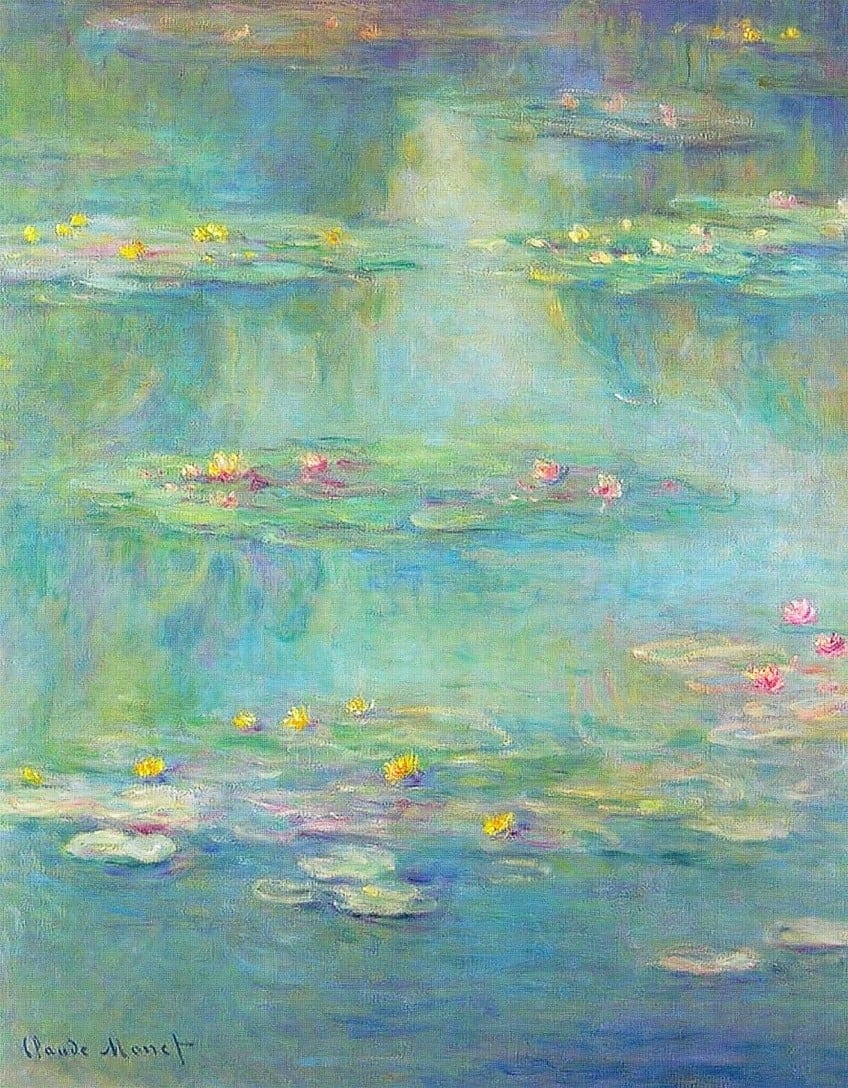
This 1908 painting was created on a circular canvas and negates the traditional landscape or vertical orientation that is common in most floral landscapes. Monet’s ability to capture the dreamy quality of the light reflected against the water and the hazy sheen of the flora on the surface of the water is remarkable. What makes this work unique in the eyes of art historians is the fact that Water Lilies could be considered an important precursor to the Abstract Expressionist movement, which was pivotal to defining Modern art in the later stages of the 20th century.
Bouquet of Roses (1909) by Pierre-Auguste Renoir
| Artist Name | Pierre-Auguste Renoir (1841 – 1919) |
| Date | 1909 |
| Art Period | French Impressionism and Modern art |
| Medium | Oil on canvas |
| Dimensions (cm) | 55.6 x 46.2 |
| Where It Is Housed | The Baltimore Museum of Art, Maryland, United States |
Renowned Impressionist flower painter Pierre-Auguste Renoir was one of the best French Impressionists of the late 19th century who created many famous and ethereal flower paintings. His approach to flower paintings was characteristic of the Impressionists style, which focused on the use of color and light to capture the essence of a scene.
Renoir’s flower paintings incorporated loose brushstrokes executed in vibrant color palettes and can be admired in one of his most famous flower paintings as seen in Bouquet of Roses.

In Bouquet of Roses, Renoir skillfully brings to life the essence of the roses arranged in such a way that evokes their tactile nature. It is as though one could reach out and feel the roses in real time. Renoir took up flower painting only later on in his career and chose to paint roses, specifically for their romantic nature.
Amaryllis (1910) by Piet Mondrian
| Artist Name | Pieter Cornelis Mondriaan (1872 – 1944) |
| Date | 1910 |
| Art Period | De Stijl, Cubism, Modern art, Expressionism, Impressionism, Fauvism, Abstract art, and Dutch Modernism |
| Medium | Watercolor on paper |
| Dimensions (cm) | 39 x 49 |
| Where It Is Housed | Private collection |
Amaryllis is among one the most famous flower paintings of all time and was created by Modern Fauvist Piet Mondrian in 1910. The renowned Dutch painter was a leading figure in Dutch Realism who was best known for his geometric abstract pieces that brought a sense of Modernism to the early 20th century. Amaryllis was painted in a striking contrast between blue and red, such that the viewer’s attention is immediately drawn to the flower. Mondrian also broke away from the traditional use of oil on canvas for the medium of watercolor, which reminds one of the scientific illustrations found in botanical art.
Amaryllis by Mondrian is also quite a unique painting by the artist who is most famous for his geometric approach to painting and use of primary colors in abstract compositions.
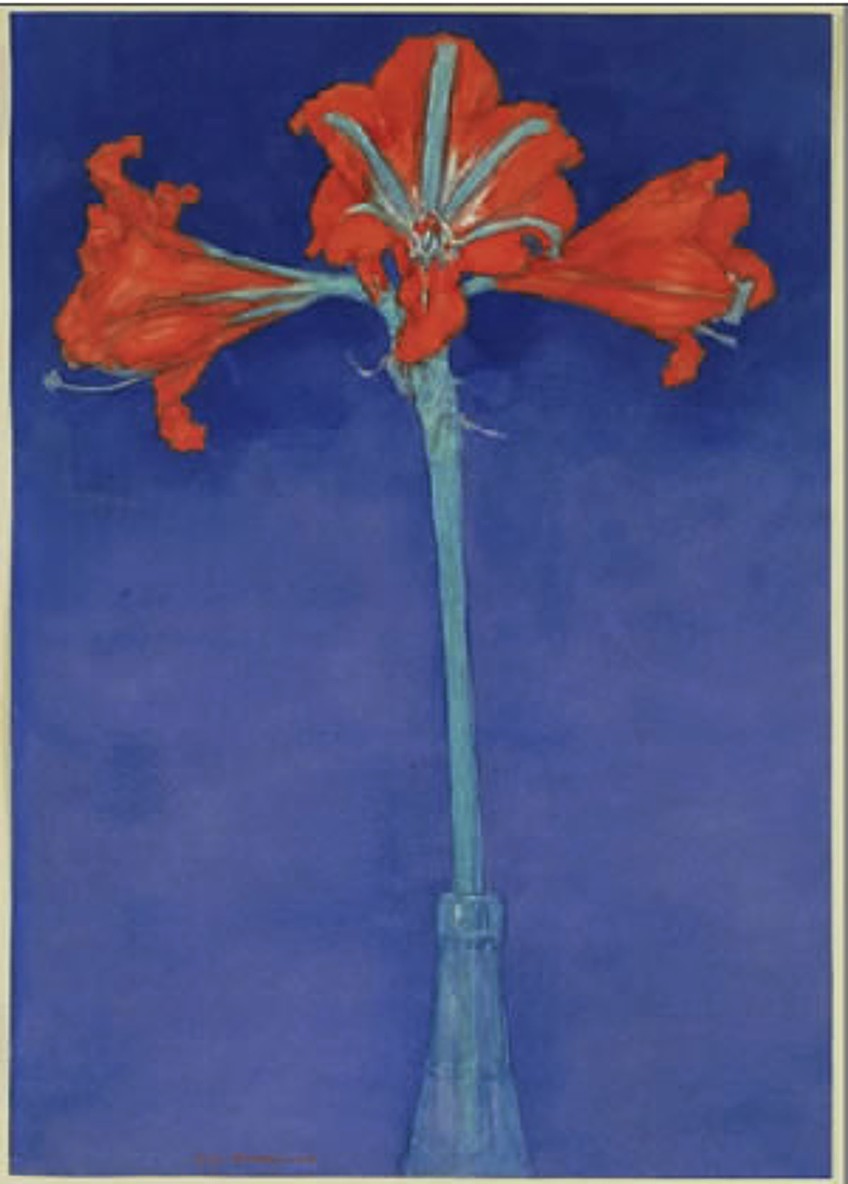
The flower is held against a solid blue background, which was a classic Mondrian choice to cast blocks of bold colors against each other for an added sense of dynamism. He also painted the petals in hues of red, white, and pink while the stem is illustrated in shades of green for another level of contrast and balance. Here, Mondrian abandoned his sense of order for a sense of chaos and spontaneity using color. The painting thus serves as a connecting piece between Mondrian’s preliminary figurative paintings and his mature abstract works that were produced later in his career.
White Vase with Flowers (1916) by Odilon Redon
| Artist Name | Odilon Redon (1840 – 1916) |
| Date | 1916 |
| Art Period | French Symbolism and Realism |
| Medium | Pastel on paper |
| Dimensions (cm) | 64.8 x 49.8 |
| Where It Is Housed | Musée d’Orsay, Paris, France |
White Vase with Flowers is one such floral artwork that had to be included on the list of the most famous flower artworks of all time. Aside from the artwork being executed in pastel, the mastery over the medium triumphs over technicalities. White Vase with Flowers was created by the French Symbolist painter and printmaker Odilon Redon, who was best known for his modern flower paintings during the late 19th and early 20th centuries.
Redon’s artistic style was defined by his use of vibrant colors in imaginative compositions that evoke a dreamlike quality, which spans the atmosphere of haunting and dreamy.
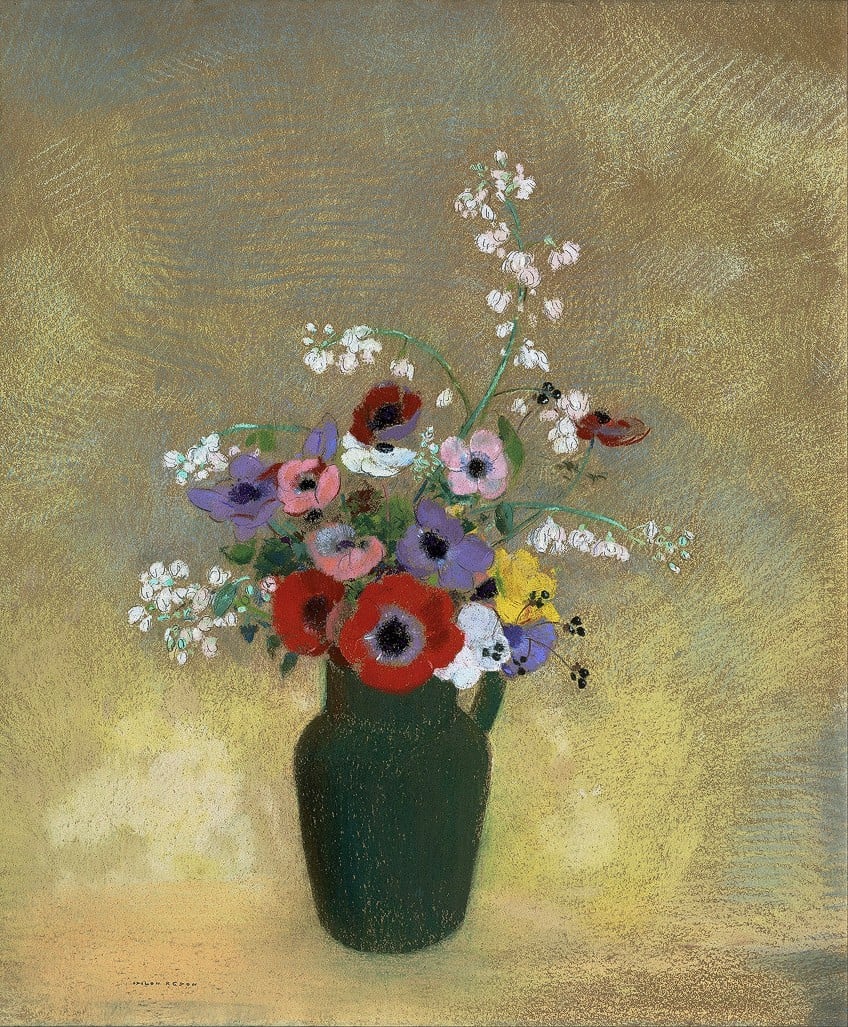
Redon’s flower paintings often include blooming arrangements that are created with luminous hues, which captivate and enthrall viewers. His flower paintings also range from highly detailed and emotive compositions to abstract renderings of flowers that all can appreciate.
Red Poppy (1927) by Georgia O’Keeffe
| Artist Name | Georgia Totto O’Keeffe (1887 – 1986) |
| Date | 1927 |
| Art Period | Modern art, Abstract art, Precisionism, and American Modernism |
| Medium | Oil on canvas |
| Dimensions (cm) | 101.6 x 76.2 |
| Where It Is Housed | Weisman Art Museum, Minnesota, United States |
Georgia O’Keeffe was one of the world’s best American Modernist artists of the mid-20th century whose contribution to Precisionism and Modern art continues to resonate across the 21st century. O’Keeffe was most famous for her erotic flower paintings and has been credited with creating over 200 floral artworks during her tenure. Her approach to still-life and watercolor painting was also celebrated and made her an icon of the American Modernism period.
By 1918, O’Keeffe began her exploration of large-scale oil painting while magnifying her natural subjects – flowers – in various intimate and striking ways.
Red Poppy is an iconic flower painting from her formative career that gives one insight into the way O’Keeffe viewed flowers. Her focus was clearly illustrated by the close-up manner in which she portrayed the petals of flowers, which also added a sense of Romanticism and Eroticism to her work. The flower petals completely dominate the canvas and invite viewers to engage in a close-up introspection around the elements of nature that might otherwise be overlooked.
Flowers (1970) by Andy Warhol
| Artist Name | Andy Warhol (1928 – 1987) |
| Date | 1970 |
| Art Period | Modern art and Pop art |
| Medium | Screen print ink on wove paper; edition of 10 |
| Dimensions (cm) | 91.7 x 91.9 |
| Where It Is Housed | Private collection |
Famous Pop artist Andy Warhol was among the most popular artists who painted flowers in the 20th century. Warhol was inspired by hibiscus flowers and the use of flower imagery in a post-war context and created a series of 10 screen prints called Flowers in 1970.
It was six years earlier that Warhol had begun exploring floral imagery in artwork and used it to create provocative works of art that became iconic images of the Modern art movement.
Through screen printing, he was also able to quickly replicate the images in bright and shocking pops of color that appealed to the Pop art movement of the 1960s and 1970s. The repetitive nature of his work on the series also evoked a sense of motion in the flowers as the viewer is presented with close-up abstractions of hibiscus flower petals.
Ready to Blossom in the Morning (1989) by Yayoi Kusama
| Artist Name | Yayoi Kusama (1929 – Present) |
| Date | 1989 |
| Art Period | Contemporary art, Pop art, Modern art, Minimalism, Environmental art, and Feminist art |
| Medium | Lithograph; edition of 100 |
| Dimensions (cm) | 38 x 46 |
| Where It Is Housed | Guy Hepner Gallery, New York City, United States |
Ready to Blossom in the Morning is a whimsical flower painting by one of the most renowned Japanese Contemporary artists, Yayoi Kusama. Kusama is a pioneer of Abstract Expressionism as well as Modern art and is most famous for her polka-dot pattern, which she uses extensively across the mediums of sculpture, painting, installation, and printmaking. Ready to Blossom in the Morning is an example of Kusama’s polka-dot-styled approach, which acts as her signature and reminds one of the Modern pointillist technique.
Her use of polka dots in her floral artwork was also inspired by hallucinatory experiences from her childhood and is recognized today as an iconic marker of the artist’s legacy.
Ready to Blossom in the Morning is a mesmerizing example of modern flower paintings captured in a bright array of bold colors. Kusama’s process in painting is informed by her meticulous and meditative state of creating, which together with repetition, generates a joyful atmosphere in her paintings and prints. Kusama’s flower paintings are significant due to their ability to demonstrate themes of transformation through life and death. She, therefore, encourages viewers to consider the transience of existence and gain a deeper appreciation for life’s fleeting qualities.
The art of painting flowers is not just an appreciation of beauty, however, it is an acknowledgement of many deeper embedded meanings that different cultures have brought to the symbolism behind floral artwork. We hope that you have thoroughly enjoyed learning about the different meanings of popular flowers in these famous paintings, as well as the ways in which some of your favorite artists have creatively included flowers into their individual practices.
Frequently Asked Questions
What Do Flowers Symbolize in Art?
Flowers have an important role in symbolism and art, and have been used in many artworks to convey emotions, religious themes, and concepts found in different cultural belief systems. In the general sense, flowers in art symbolize beauty, fertility, the cycle of life, death, youth, and love. Furthermore, different flowers can also symbolize different themes, including purity, wealth, hope, passion, and enlightenment.
Who Were the Leading Flower Painters of the 20th Century?
The leading flower painters of the 20th century include prominent figures such as Claude Monet, Georgia O’Keeffe, Pierre-Auguste Renoir, Frida Kahlo, Vincent van Gogh, Henri Matisse, Odilon Redon, Yayoi Kusama, and Andy Warhol.
What Flowers Were Most Often Represented in Art History?
Among the many flower species available for artists to represent in art history, some of the most popular flowers include roses, lilies, the lotus flower, irises, sunflowers, chrysanthemums, and peonies.
Jordan Anthony is a Cape Town-based film photographer, curator, and arts writer. She holds a Bachelor of Art in Fine Arts from the University of the Witwatersrand, Johannesburg, where she explored themes like healing, identity, dreams, and intuitive creation in her Contemporary art practice. Jordan has collaborated with various local art institutions, including the KZNSA Gallery in Durban, the Turbine Art Fair, and the Wits Art Museum. Her photography focuses on abstract color manipulations, portraiture, candid shots, and urban landscapes. She’s intrigued by philosophy, memory, and esotericism, drawing inspiration from Surrealism, Fluxus, and ancient civilizations, as well as childhood influences and found objects. Jordan is working for artfilemagazine since 2022 and writes blog posts about art history and photography.
Learn more about Jordan Anthony and about us.
Cite this Article
Jordan, Anthony, “Famous Flower Paintings – Exploring the Best Floral Paintings.” artfilemagazine – Your Online Art Source. May 11, 2023. URL: https://artfilemagazine.com/famous-flower-paintings/
Anthony, J. (2023, 11 May). Famous Flower Paintings – Exploring the Best Floral Paintings. artfilemagazine – Your Online Art Source. https://artfilemagazine.com/famous-flower-paintings/
Anthony, Jordan. “Famous Flower Paintings – Exploring the Best Floral Paintings.” artfilemagazine – Your Online Art Source, May 11, 2023. https://artfilemagazine.com/famous-flower-paintings/.


